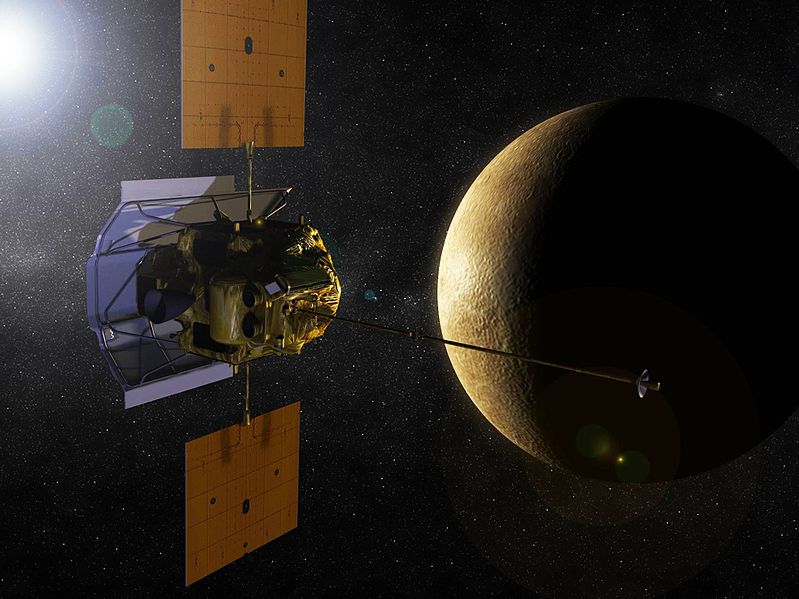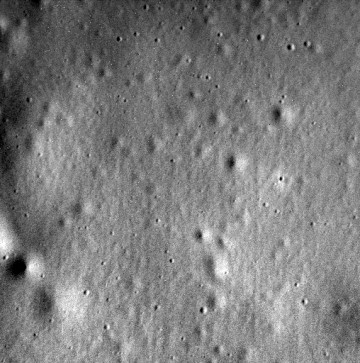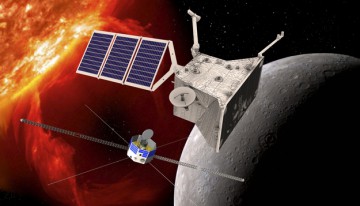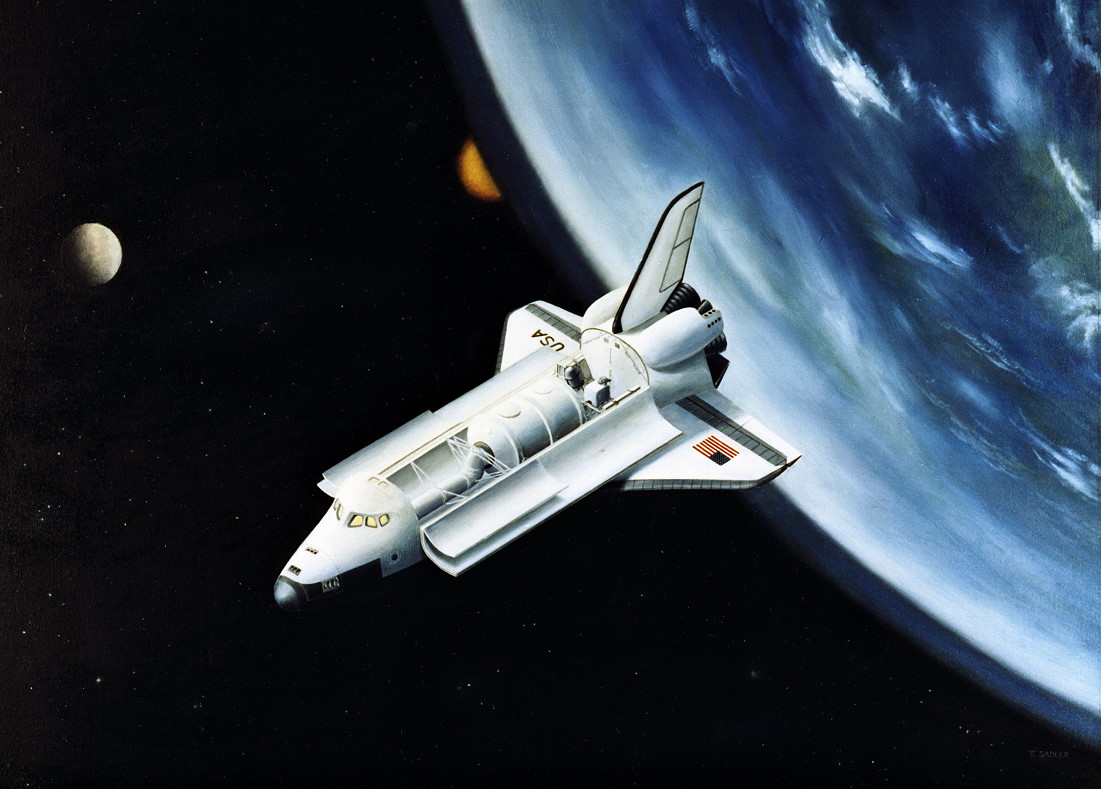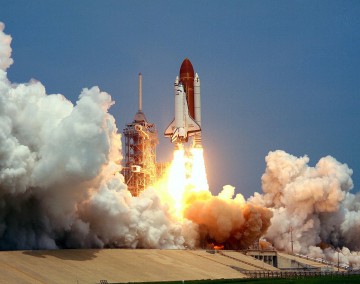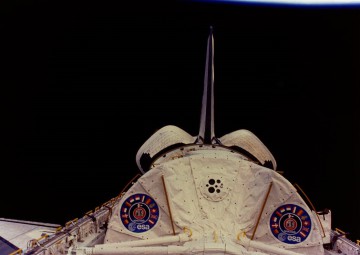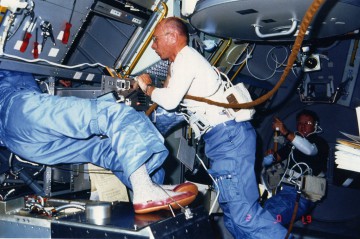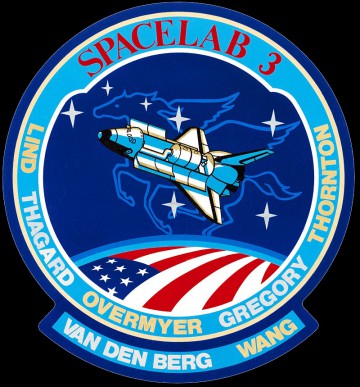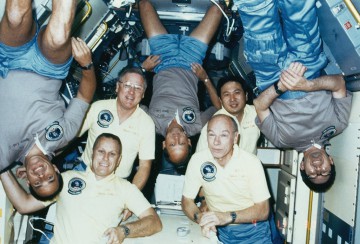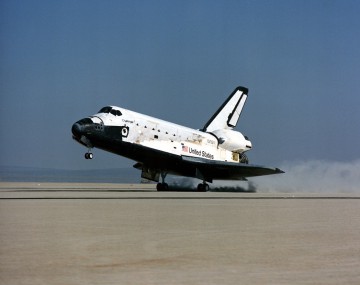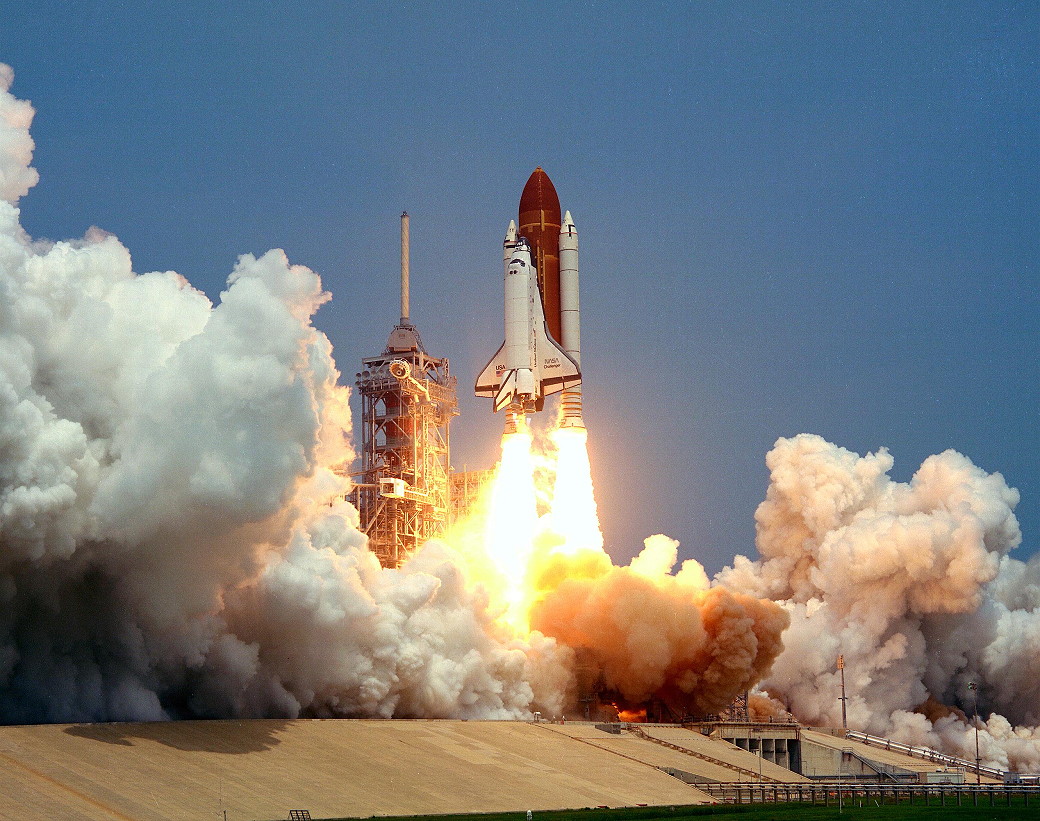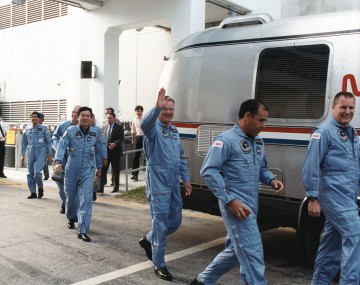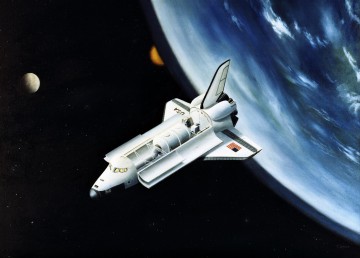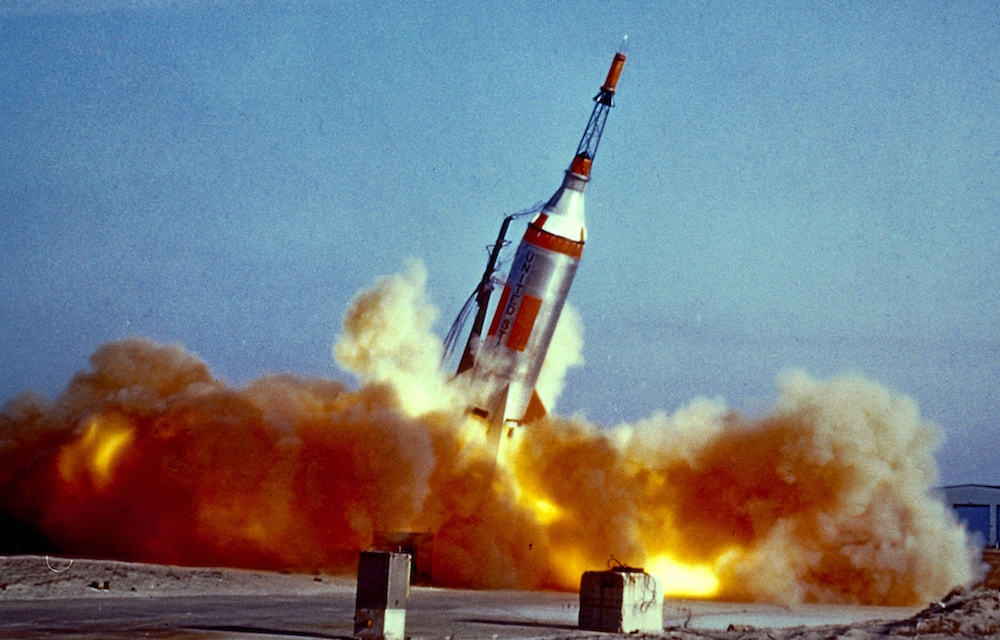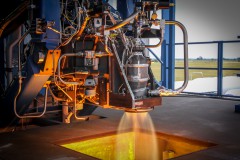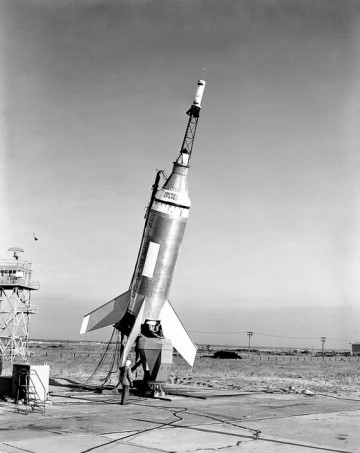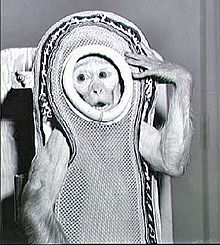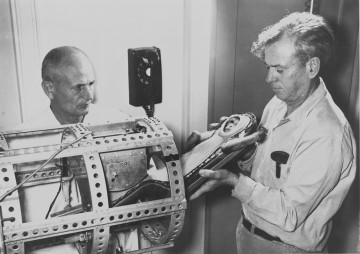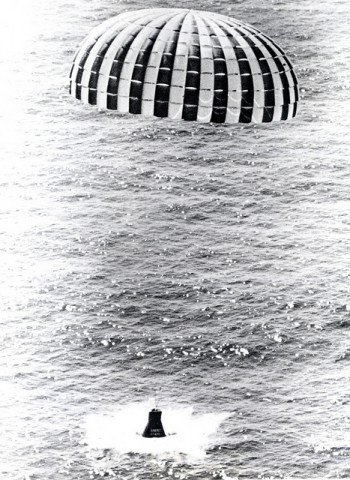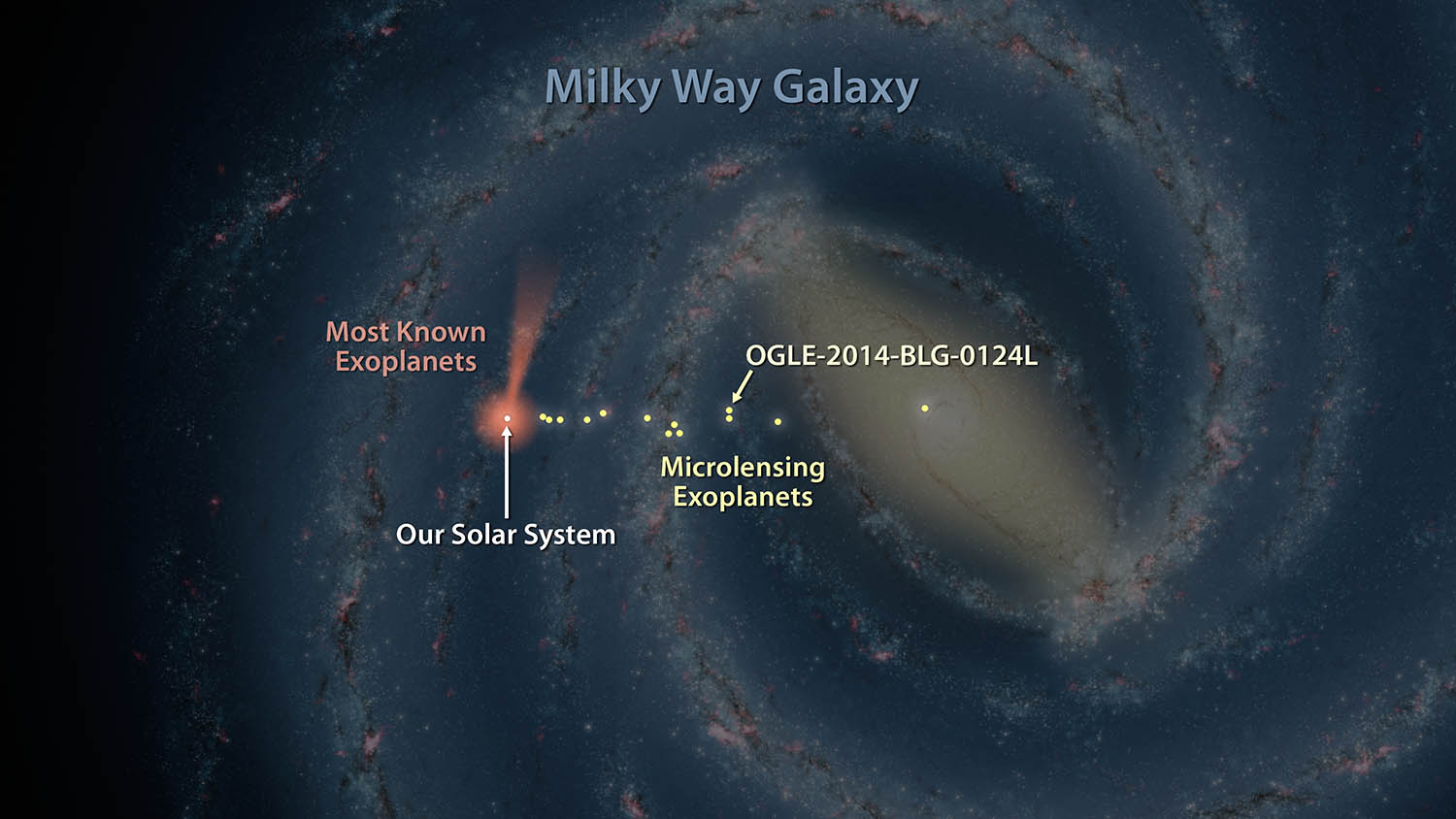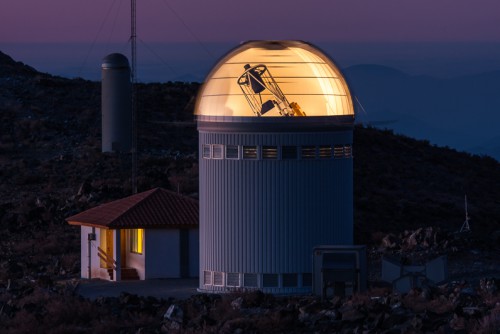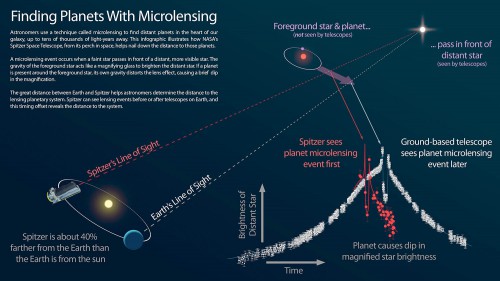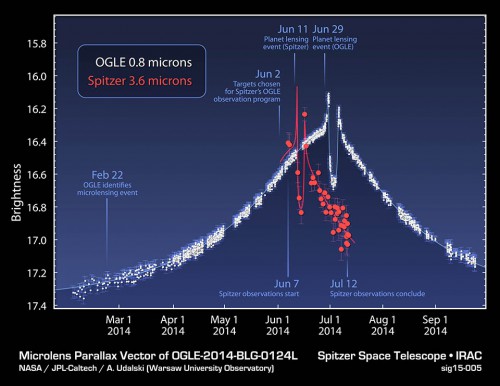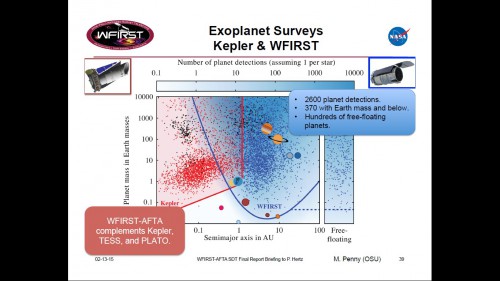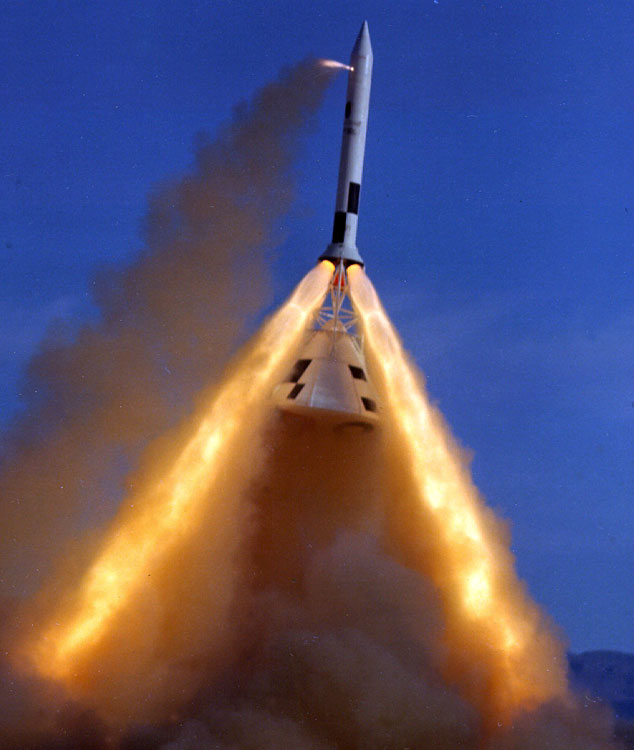
The
launch escape apparatus pulls an Apollo Command Module (CM) to safety
during the Pad Abort Test-2 in June 1965. Photo Credit: NASA
Tomorrow, if all goes well, more than 120,000 pounds (54,430 kg) of thrust
will rock Space Launch Complex (SLC)-40 at Cape Canaveral Air Force Station, Fla.,
as SpaceX stages the long-awaited Pad Abort Test of its crewed Dragon
spacecraft. The test, which is part of the Commercial Crew integrated
Capability (CCiCap) contract with NASA and comes only months
after SpaceX was awarded a slice of the $6.8 billion Commercial Crew transportation Capability (CCtCap) “pie,” will
see eight side-mounted SuperDraco thrusters boost the
soon-to-be-piloted capsule to an altitude of 5,000 feet (1,500 meters)
and about 6,000 feet (1,800 meters) eastwards, after which Dragon will
execute a parachute-guided splashdown in the Atlantic Ocean.
Wednesday’s test will be dramatic,
indeed, and represents a critical milestone as SpaceX aims to deliver
U.S. astronauts to the International Space Station (ISS), aboard a U.S.
spacecraft, and from U.S. soil, by mid-2017. Yet it is actually the
latest in a long line of pad abort tests over more than five decades,
which have served to prove the safety and flightworthiness of U.S.
crewed vehicles.
If all goes according to plan on Wednesday morning—and SpaceX has
already explained that “Winds above 25 knots and Phase II Lightning are
the primary Range weather constraints”—the Pad Abort Test will get
underway at 7 a.m., about 22 minutes after local sunrise. “Winds have
become gusty out of the east and will remain so for the next couple of
days as a low-pressure area develops south-east of Central Florida,” it
was highlighted
by the 45th Weather Squadron in an update on Monday.
“The increase in winds also increases the threat of showers along the
Space Coast. Showers will be most prevalent in the morning hours and
typically diminish after noon. On Wednesday, the low-pressure area will
drift north and east, relaxing the pressure gradient, which will result
in lower wind speeds over the Spaceport.” Maximum winds to 5,000 feet
(1,500 meters) are expected to be easterly at 20 knots, producing
a 70-percent likelihood of acceptable conditions on Wednesday. That
probability is expected to improve to 80-percent favourable on the
backup day on Thursday, as the low-pressure region continues to move
north-west and winds continue to weaken. In the event of a 24-hour
scrub, the maximum winds to 5,000 feet (1,500 meters) on Thursday will
be north-easterly at 17 knots.
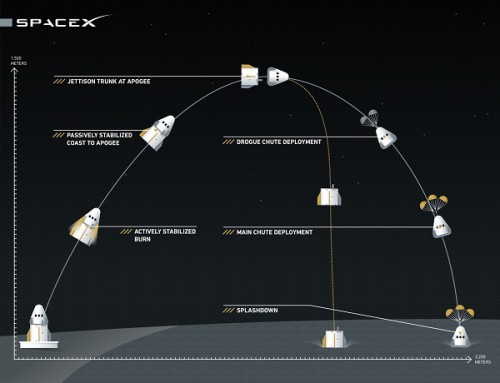
Abort trajectory profile for tomorrow’s Dragon Pad Abort Test. Image Credit: SpaceX
Although the test will occur from SLC-40, which is the same site as
used last week for the TurkmenÄlem52E/MonacoSat launch, several key
modifications were performed on Thursday, 30 April. Notably, the
high-level catenary lines for lightning protection have been removed and
a truss structure to support the Dragon vehicle at ground level was
installed over the SLC-40 flame trench.
At T-0, the eight hypergolic SuperDraco thrusters, built into the
sides of the Dragon, will roar to life and ramp up to their maximum
120,000 pounds (54,430 kg) of thrust. This impetus will propel the
vehicle away from SLC-40. “After half a second of vertical flight, Crew
Dragon pitches toward the ocean and continues its controlled burn,”
SpaceX reported Monday, 4 May. “The SuperDraco engines throttle to
control the trajectory, based on real-time measurements from the
vehicle’s sensors.” Two seconds into the ascent, the spacecraft will
have already attained an altitude of 328 feet (100 meters) and will hit
1,640 feet (500 meters) at five seconds. “The abort burn is terminated
once all propellant is consumed,” it was continued, “and Dragon coasts
for just over 15 seconds to its highest point about 0.93 miles (1,500
meters) above the launch pad.”
The unpressurized “trunk” will be jettisoned at T+21 seconds and the
Dragon capsule will commence a slow rotation, with its base heat shield
positioned towards the ground. Four seconds later, the drogue parachutes
will be deployed, within a 4-6 second window, stabilizing the
vehicle in advance of the unfurling of the three main canopies at T+35
seconds. Current expectations are that the Dragon capsule will hit the
waters of the Atlantic Ocean at T+107 seconds, with the impact point
predicted about 1.4 miles (2,200 meters) downrange of SLC-40.
During Wednesday’s test, SpaceX hopes to acquire significant data in
the areas of Sequencing, Closed-Loop Control, Trajectory and External
and Internal Environments. It will demonstrate the proper sequencing of
the pad-abort timeline, serving to validate the execution of multiple
critical commands in a very short period, as well as testing as many as
eight SuperDracos in unison for the first time. It will obtain
trajectory data for both maximum altitude and downrange distance from
the pad and will gather data on “various internal and external factors
to Crew Dragon to help ensure safe conditions for crew transport.”
Interestingly, SpaceX also noted that the crash test dummy is actually
not nicknamed “Buster”, despite
media reports to the contrary and SpaceX Vice President of Mission Assurance Hans Koenigsmann referring to the dummy as such
during last Friday’s press briefing.
“Buster the Dummy already works for a great show you may have heard of,
called MythBusters,” SpaceX said in a press statement Monday. “Our
dummy prefers to remain anonymous for the time being.”
However, Wednesday’s Pad Abort Test is the latest in a long series of
such exercises to validate pad systems, booster systems and spacecraft
systems, ahead of piloted flights.
As described in yesterday’s AmericaSpace article,
the Little Joe booster advanced U.S. knowledge of the intricacies of
high-altitude abort events in readiness for Project Mercury, and its
immediate descendent (the “Little Joe II”) was employed between August
1963 and January 1966 for five unmanned tests of the escape system for
the Apollo Command and Service Module (CSM),
as America strove to plant human bootprints on the Moon before the decade’s end.
Early studies for Little Joe II (initially dubbed “Little Joe Senior”)
got underway in mid-1961, not long after the completion of Little Joe’s
involvement with Project Mercury. It would be required to support two
launches in 1963 for tests in the Max Q region—an area of maximum
aerodynamic turbulence upon a launch vehicle’s flight surfaces,
typically encountered about a minute into ascent—followed by two
very-high-altitude atmospheric aborts and finally a “Confirming Max Q
Abort.” In May 1962, General Dynamics/Convair won the contract to
develop the Little Joe II vehicle, with White Sands Missile Range, near
Alamagordo, N.M., chosen as the launch site.
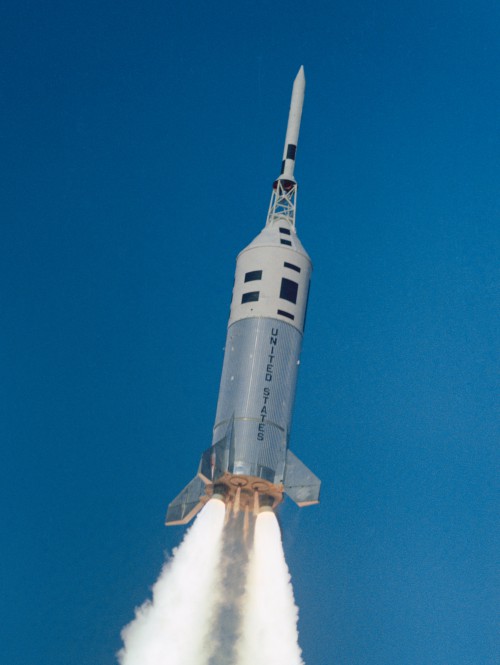
The
A-002 Little Joe II mission delivers a boilerplate Apollo Command and
Service Module (CSM) to altitude on 8 December 1964. Photo Credit: NASA
As preparation work got underway, Aerojet-General’s Algol-1D
solid-fueled rocket engine—capable of 98,916 pounds (44,870 kg) of
propulsive yield—was selected as the main “sustainer” motor,
supplemented by a clustered arrangement of six Recruit engines,
producing a total thrust of 228,000 pounds (103,420 kg). Resized to
accommodate the much larger Apollo CSM, the Little Joe II stood 33.1
feet (10.1 meters) tall—rising to 85.9 feet (26.2 meters), with the
payload affixed—and 12.8 feet (3.9 meters) in diameter, with a span
across the four aerodynamic stabilization fins at its base of 28.5 feet
(8.7 meters). The stack was then topped by the launch escape apparatus, a
truncated rectangular pyramid which acted as an intermediate structure
between the CSM and the four solid-propellant tower-jettison motors,
which produced 155,000 pounds (70,000 kg) of thrust to pull the
spacecraft away from a failed booster.
It was agreed that the maiden voyage of the Little Joe II would be
for qualification purposes, and in the meantime, by March 1963, the
first booster had emerged from production and was delivered to White
Sands at the end of April. The Qualification Test Vehicle (QTV) followed
in mid-July and was successfully fired from Army Launch Area (ALA)-3 on
28 August, carrying a dummy aluminum shell in the basic shape of the
Apollo CSM and an inert launch escape system. In spite of failing to
destruct when commanded, due to an improperly installed primacord, the
Little Joe II reached a maximum altitude of 4.5 miles (7.3 km), covered a
distance of 8.7 miles (14 km) and accomplished its test objectives to
determine base pressures and heating on the vehicle.
Six months later, in February 1964, the second Little Joe II arrived
at White Sands, and a boilerplate Apollo CSM was installed at the end of
March, prior to the “A-001” flight on 13 May. With the six Recruit
motors firing for 1.5 seconds and the Algol-1D sustainer operating for
42 seconds, the flight attained an altitude of 3.1 miles (5 km) and at
44 seconds accomplished the first successful abort with a “live” launch
escape system. The landing sequence of the spacecraft also ran normally,
with the exception of a failure of one of the mortar-deployed main
parachutes, which produced a faster than intended landing. A third
(“A-002”) mission took place on 8 December and evaluated the
effectiveness of the launch escape system at equivalent pressures and
stresses to those expected during a Saturn IB or Saturn V ascent.
On 19 May 1965, the fourth (“A-003”) mission failed in spectacular
fashion when one of the Little Joe II’s four stabilizing fins failed,
inducing an uncontrollable roll and precipitating the disintegration of
the vehicle. A subsequent NASA-General Dynamics/Convair investigation
revealed that the No. IV fin inadvertently moved into a “hard-over”
position, about a second after liftoff, due to an internal mechanical
failure. By 2.5 seconds into the flight, the fin had reached a fully
deflected position, where it remained until the vehicle disintegrated.
Consequently—and a little ironically—
what should have been an abort test turned into a real abort situation, although it was executed at low altitude, rather than the intended higher altitude.
“The faster the rocket went up, the faster it spun around,”
remembered instrumentation and electronics engineer Gary Johnson in a 2010 NASA oral history, who observed the A-003 failure. “It had six solid-rocket motors … and those six motors all just
came apart.
We were only a half-mile away from the launch pad and, all of a sudden,
these rockets were coming flying in every direction, almost like they
were coming back at us, but they weren’t, of course.” However, the
launch escape system fired on time and successfully pulled the Apollo
CSM away from the blazing booster and it parachuted to safety.
Also watching the ill-fated A-003 ascent
was NASA’s Little Joe II Program Manager Milt Silveira
and his wife. “The vehicle started to roll, and when it rolled to the
point, structurally, [that] it wouldn’t take it, and it blew apart, and
then the payload aborted off the launch vehicle,”
Silveira told the NASA oral historian in 2005. “So it was a little
more
realistic than what we thought! It was supposed to go to a hundred
miles down, around, and downrange, and it only went about twenty. But it
scattered aluminum all over the sky and things like that. It was a
very realistic test from that point, even though it wasn’t the planned one.”
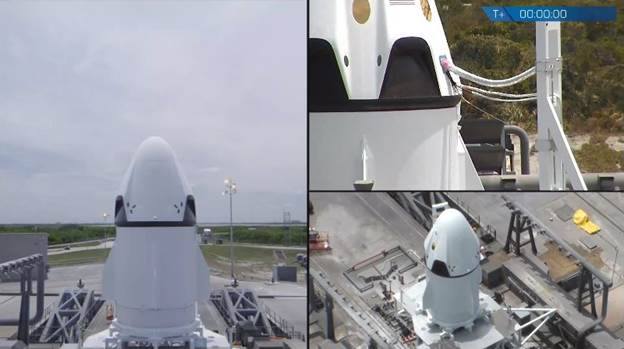
The SpaceX Crew Dragon Pad Abort Test vehicle atop SLC-40 / Cape Canaveral AFS, Fla. Photo Credit: SpaceX
“The lesson out of that was the abort system to initiate the abort
for the spacecraft and the launch vehicle consisted of the opening-up of
the circuit between the spacecraft and the launch vehicle to initiate
the abort,” added Gary Johnson in his recollection of the events of that
day. “When the launch vehicle came apart, that in itself opened up that
wiring and automatically initiated the Launch Escape System. The pyros
fired to separate the Command Module from the launch vehicle, the launch
escape motor went off, the pitch-control motor went off, and it went
through the entire sequence, which consisted of tower jettison,
deploying the apex cover, putting out the drogue parachutes, putting out
the main parachutes and then safely recovering the vehicle. The lesson
there was on any future vehicles, one of the abort sensors should be
this wiring that goes down to the launch vehicle such that if it ever
opens up due to a launch vehicle blow-up or structural break-up, it
would automatically, without any other indication, initiate the abort.”
The final, seven-minute-long Little Joe II test (“A-004”) occurred on
20 January 1966, delivering a production Apollo Block I spacecraft
(CSM-002) to a peak altitude of 14 miles (23 km) and demonstrating its
twin objectives of proper LES orientation/stabilization and full
structural integrity of the escape vehicle.
In the meantime, separate tests were also underway to demonstrate the
capacity of the launch escape system to pull the spacecraft away from
an exploding booster on the pad. Unlike Little Joe II altitude flights,
which sought to demonstrate the system’s capability to boost a
spacecraft away from a failing booster in high-dynamic-pressure
conditions, a pair of Pad Abort Tests, also at LC-36 at White Sands, saw
the launch escape mechanism fired at ground level. On 7 November 1963,
Pad Abort Test-1 successfully lifted a boilerplate Apollo CSM and
attached Launch Escape System (LES) from LC-36. Fifteen seconds into the
abort, the LES separated and the CM successfully parachuted to a safe
landing. With the exception of soot deposited on the spacecraft’s
exterior surfaces and a less-than-predicted stability, the 165-second
test was considered a great success, reaching a peak altitude of 1.7
miles (2.8 km). This was followed by a highly successful Pad Abort
Test-2 on 29 June 1965, closing out Little Joe’s final involvement with a
soon-to-be-piloted spacecraft.
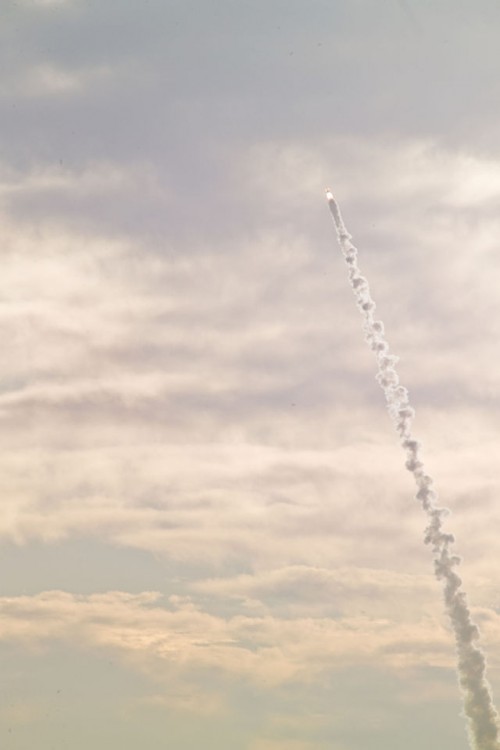
A mockup of NASA’s Orion spacecraft is boosted to altitude on 6 May 2010. Photo Credit: NASA
It would be more than four decades—well into the twilight of the
space shuttle era—before a series of pad abort testing of an entirely
new U.S. piloted spacecraft took place.
Following NASA’s August 2006 announcement that Lockheed Martin would be prime contractor for the Orion spacecraft, the initial contracts
were expanded in April of the following year
with plans for two tests of a Launch Abort System (LAS). That same
month, NASA partnered with the Air Force’s Space Development and Test
Wing at Kirtland Air Force Base, near Albuquerque, N.M., to stage a
series of tests between 2008-2011 of an mechanism to pull Orion to
safety in the event of a launch malfunction. “A total of six tests are
planned, pending environmental assessments,”
it was reported.
“Two will simulate an abort from the launch pad and will not require a
booster. The rest will use abort test boosters and simulate aborts at
three stressing conditions along the … launch vehicle trajectory.”
Groundbreaking operations for the construction of the abort test pads
got underway at the Army’s White Sands Missile Range, near Las Cruces,
N.M.,
in November 2007, and the solid-fueled motor to jettison the LAS was static-fired by prime contractor Aerojet
in April 2008.
The Pad Abort Test-1 took place at White Sands—the very same location
from where the Little Joe II launches originated, so many years earlier—
on 6 May 2010. An abort motor, with a momentary 500,000 pounds (226,800 kg) of thrust,
burned for six seconds to boost Orion away from the pad.
It reached a peak velocity of 540 mph (870 km/h).
Simultaneously, a
7,000-pound-thrust (3,170 kg) attitude control motor was also ignited to
provide steering, whilst a jettison motor pulled the LAS away from the
capsule to permit parachute deployment and a safe landing. Overall, Pad
Abort-1 lasted 135 seconds and Orion was brought to a touchdown about a
mile (1.6 km) north of the pad. At the time of writing, an Orion Ascent
Abort Test (AA-2) is planned from Space Launch Complex (SLC)-46 at Cape
Canaveral Air Force Station, Fla., in 2018.
With SpaceX’s fellow CCtCap winner, Boeing, expected to conduct its
own Pad Abort Test in support of its CST-100 spacecraft, sometime next
year, ahead of inaugural unpiloted and manned missions in 2017, the roar
of abort engines on Wednesday morning promises to be a significant
milestone as these new crew-carrying vehicles draw closer to maturity.
As cautioned by NASA’s Jon Cowart and SpaceX’s Hans Koenigsmann in
Friday’s press briefing, the Dragon Pad Abort Test is a development
test, “not a shiny, well-polished Space Shuttle launch.” Its ascent will
be neither slow or sedate; rather, it will blaze to 5,000 feet (1,500
feet) in about six seconds, before the capsule plummets back to an
oceanic splashdown. “I can hold my breath the entire time,” quipped
Koenigsmann.
However, what we should see on Wednesday morning will draw more than a
few uncanny parallels with the Little Joe missions of yesteryear. It
will also closely mirror the Beach Abort Test from 9 May 1960,
which was described as
“a sterling qualification test, but … hardly spectacular to the
public.” Speaking back in 1999, Rodney Rose recalled inviting the media
to one of the early Little Joe tests. On one occasion, Rose briefed a
group of photojournalists about what they were about to behold.
“Well, this is not quite like what you’re used to, guys,” he explained. “This thing goes off pretty fast.”
“No sweat,” came the reply from one of the photojournalists. “We’ll follow that.”
On the morning of the test, however, he zoomed his camera in on the
pad … and missed the Little Joe completely, so rapid was its departure
and ascent. “Where did it
go? Where did it
go?” the
hapless photojournalist asked Rose. He had failed to appreciate the
sheer impetus with which the launch escape system propelled its precious
payload away from the booster. “Six G makes a
difference,” Rose explained, “because, you know, 1.1 or less G, they take off pretty sedately from the Cape.”
And therein lies the singular lesson of a Pad Abort Test: Whatever
happens on Wednesday morning—whether spectacular to the public or
not—the lesson is to Watch Carefully.
For one thing is certain:
It’ll be fast.
